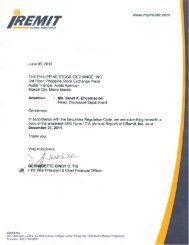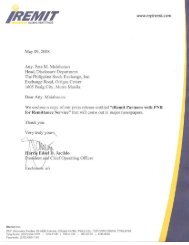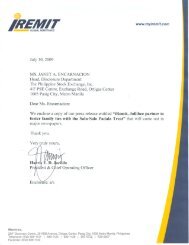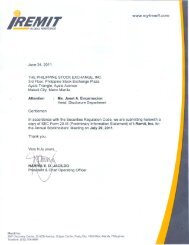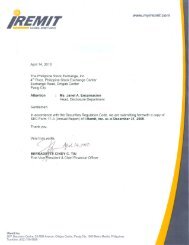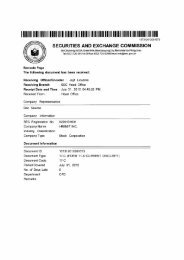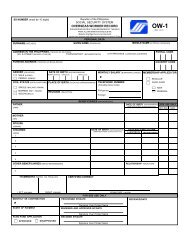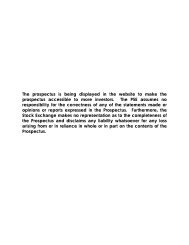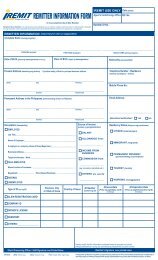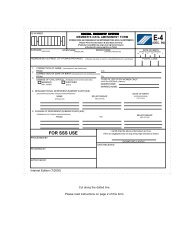- 19 - As of December 31, <strong>20</strong>11 the carrying values of Property and equipment and Software costs follow: <strong>20</strong>11 <strong>20</strong>10 Property and equipment - net (Note 11) P=7,094,474 P=9,493,115 Software costs - net (Note 12) 1,396,241 1,868,072 In <strong>20</strong>11, <strong>20</strong>10 and <strong>20</strong>09, the Parent Company recognized depreciation and amortization in the statements of income amounting to P=6.54 million, P=8.06 million and P=8.61 million, respectively. d. Recognition of deferred tax assets The Parent Company reviews the carrying amounts of deferred tax assets at each balance sheet date and reduces it to the extent that it is no longer probable that sufficient taxable income will be available to allow all or part of the deferred tax assets to be utilized. Significant judgment is required to determine the amount of deferred tax assets that can be recognized, based upon the likely timing and level of future taxable income together with future tax planning strategies. As of December 31, <strong>20</strong>11 and <strong>20</strong>10, the Parent Company did not recognize net deferred tax assets on existing deductible temporary differences amounting to P=2.80 million and P=2.85 million, respectively. Management believes that it is not highly probable that these temporary differences will be realized in the future (see Note 23). e. Present value of net retirement obligation The cost of defined benefit retirement plan and other post-employment benefits are determined using actuarial valuations. The actuarial valuation involves making assumptions about discount rates, expected rates of return on assets, future salary increases, mortality rates and future retirement increases. Due to the long-term nature of these benefits, such estimates are subject to significant uncertainty. The assumed discount rates were determined using the market yields on Philippine government bonds with terms consistent with the expected employee benefit payout as of the consolidated balance sheet date. Refer to Note 16 for the details of assumptions used in the calculation. As of December 31, <strong>20</strong>11 and <strong>20</strong>10, the Parent Company recognized retirement asset of P=0.37 million and retirement liability of P=0.78 million, respectively. In <strong>20</strong>11, <strong>20</strong>10 and <strong>20</strong>09, the Parent Company recognized retirement expense amounting to P=5.75 million, P=2.38 million and P=3.02 million, respectively (see Note 16). f. Share-based payment transactions The Parent Company determined the cost of its equity-settled share based program at grant date using the price earnings multiple model taking into account the terms and conditions upon which the shares were granted. At yearend, the Parent Company estimates the number of equity instruments that will ultimately vest. The Parent Company recognized cost of equity-settled share based payments amounting to P=1.53 million in <strong>20</strong>09 (see Note 17). The vesting period of the stock purchase program ended on September 19, <strong>20</strong>09. *SGVMC116501*
4. Fair Value Measurement - <strong>20</strong> - The following tables summarize the carrying amounts and fair values of the Parent Company’s financial assets and financial liabilities: <strong>20</strong>11 <strong>20</strong>10 Carrying Value Fair Value Carrying Value Fair Value Financial Assets Loans and receivables: Cash and cash equivalents Cash on hand P=24,772,521 P=24,772,521 P=41,745,551 P=41,745,551 Cash in banks Accounts receivable 642,750,978 642,750,978 685,9<strong>20</strong>,368 685,9<strong>20</strong>,368 Agents 993,280,050 993,280,050 1,081,402,745 1,081,402,745 Couriers Other receivables 3,523,052 3,523,052 34,283,<strong>20</strong>1 34,283,<strong>20</strong>1 Related parties 137,260,244 137,260,244 97,767,888 97,767,888 Advances to officers and employees 2,526,259 2,526,259 2,991,428 2,991,428 Noncontrolling shareholders – – 39,981,243 39,981,243 Others 3,457,329 3,457,329 1,166,686 1,166,686 Refundable deposits 4,568,661 4,492,159 4,099,931 3,860,098 Total P=1,812,139,094 P=1,812,062,592 P=1,989,359,041 P=1,989,119,<strong>20</strong>8 Other Financial Liabilities Beneficiaries and other payables: Beneficiaries P=155,140,304 P=155,140,304 P=144,960,550 P=144,960,550 Advances from related parties 79,753,117 79,753,117 74,161,090 74,161,090 Agents, couriers and trading clients 44,404,974 44,404,974 27,101,817 27,101,817 Accrued expenses 7,019,510 7,019,510 6,250,462 6,250,462 Payable to suppliers 1,391,836 1,391,836 2,958,634 2,958,634 Others 476,730 476,730 803,350 803,350 Interest-bearing loans 666,000,000 666,000,000 877,000,000 877,000,000 Total P=954,186,471 P=954,186,471 P=1,133,235,903 P=1,133,235,903 The following methods and assumptions were used to estimate the fair value of the financial instruments: Cash and cash equivalents, Accounts receivable, Other receivables, Beneficiaries and other payables and Interest-bearing loans - carrying amounts approximate fair values due to the relatively short-term maturities of these instruments. Refundable deposits - fair values are based on the present value of future cash flows discounted using prevailing interest rates ranging from 1.56% to 2.14% and 2.31% to 3.12% as at December 31, <strong>20</strong>11 and <strong>20</strong>10, respectively. As of December 31 <strong>20</strong>11 and <strong>20</strong>10, the Parent Company has no financial instruments carried at fair value. 5. Financial Risk Management Objectives and Policies The Parent Company’s principal financial instruments mainly comprise of short-term loans from banks. The main purpose of these financial instruments is to raise funds for the Parent Company’s fulfillment or delivery of remittance transactions to beneficiaries. The Parent Company also has various other financial assets and liabilities such as cash and cash equivalents, accounts receivable and accounts payable to beneficiaries, which arise directly from its remittance operations. *SGVMC116501*
- Page 1 and 2:
• 1!I~lJllr June 25, 2012 THE PHI
- Page 3 and 4:
IRE:lftlr I-Remit, Inc. TO: ALL STO
- Page 5 and 6:
GENERAL INFORMATION Date, time and
- Page 7 and 8:
Note: The PCD Nominee Corporation (
- Page 9 and 10:
Harris Edsel D. Jacildo Mr. Jacildo
- Page 11 and 12:
Mr. Tan has also been the Corporate
- Page 13 and 14:
Ronald A. Benito Mr. Benito joined
- Page 15 and 16:
Involvement in Certain Legal Procee
- Page 17 and 18:
The compensation of the key managem
- Page 19 and 20:
Compensation Plans As described abo
- Page 21 and 22:
SIGNATURES After reasonable inquiry
- Page 23 and 24:
I-Remit Australia Pty Ltd, a wholly
- Page 25 and 26:
Properties I-Remit, Inc. and its su
- Page 27 and 28:
Company’s shareholders. Any stock
- Page 29 and 30:
Committees of the Board of Director
- Page 31 and 32:
Plan of Operation MANAGEMENT’S DI
- Page 33 and 34:
Full Years 2011 compared to 2010 I-
- Page 35 and 36:
Total liabilities declined by PHP 1
- Page 37 and 38:
2010 compared to 2009 I-Remit reali
- Page 39 and 40:
IREMIT EUROPE Remittance Consulting
- Page 41 and 42:
I-Remit New Zealand Limited Perform
- Page 43 and 44:
Below are the comparative key perfo
- Page 45 and 46:
Goodwill decreased by PHP 1.5 milli
- Page 47:
IREMIT Remittance Consulting GmbH M
- Page 64 and 65:
I-REMIT, INC. AND SUBSIDIARIES NOTE
- Page 66 and 67:
- 3 - Statement of Compliance The a
- Page 68 and 69:
- 5 - Changes in Accounting Policie
- Page 70 and 71:
- 7 - deferred cumulative amount pr
- Page 72 and 73:
- 9 - For all other financial instr
- Page 74 and 75:
- 11 - Estimates of changes in futu
- Page 76 and 77:
- 13 - Gains or losses arising from
- Page 78 and 79:
- 15 - Once a financial asset or a
- Page 80 and 81:
- 17 - Income Taxes Current tax Cur
- Page 82 and 83:
- 19 - Related party relationships
- Page 84 and 85:
- 21 - PFRS 13, Fair Value Measurem
- Page 86 and 87:
- 23 - d. Discontinued Operations M
- Page 88 and 89:
- 25 - As of December 31, 2011 and
- Page 90 and 91:
- 27 - The following methods and as
- Page 92 and 93:
- 29 - As at December 31, 2011, the
- Page 94 and 95:
- 31 - Change in nominal 2010 Chang
- Page 96 and 97:
6. Cash and Cash Equivalents This a
- Page 98 and 99:
10. Other Current Assets This accou
- Page 100 and 101:
Office and Communication Equipment
- Page 102 and 103:
- 39 - value of the additional inte
- Page 104 and 105:
16. Interest-Bearing Loans - 41 - T
- Page 106 and 107:
- 43 - The Group’s objective is t
- Page 108 and 109:
The major categories of plan assets
- Page 110 and 111:
- 47 - (f) On July 1, 2011, the Par
- Page 112 and 113: - 49 - In the ordinary course of bu
- Page 114 and 115: - 51 - The table below shows the in
- Page 116 and 117: - 53 - Segment information as of an
- Page 118: - 55 - The results of IRCGmbH’s o
- Page 121 and 122: - 1 - I-REMIT, INC. SCHEDULE OF RET
- Page 123 and 124: - 3 - Schedule II Page 2 of 5 PFRSs
- Page 125 and 126: - 5 - Schedule II Page 4 of 5 Impor
- Page 127 and 128: - 7 - I-REMIT, INC. AND SUBSIDIARIE
- Page 129 and 130: Name of Debtor - 9 - I-Remit, Inc.
- Page 131 and 132: - 11 - I-Remit, Inc. and Subsidiari
- Page 133 and 134: - 13 - I-Remit, Inc. and Subsidiari
- Page 135 and 136: Title of Issue (i) Number of shares
- Page 144 and 145: I-REMIT, INC. NOTES TO PARENT COMPA
- Page 146 and 147: - 3 - The adoption of the following
- Page 148 and 149: - 5 - After initial measurement, ot
- Page 150 and 151: - 7 - If the Parent Company determi
- Page 152 and 153: - 9 - assets or groups of assets, i
- Page 154 and 155: - 11 - actuarial gains and losses a
- Page 156 and 157: - 13 - A change in the ownership in
- Page 158 and 159: - 15 - PFRS 11, Joint Arrangements
- Page 160 and 161: - 17 - d. Contingencies The Parent
- Page 164 and 165: - 21 - The main risks arising from
- Page 166 and 167: - 23 - The following tables set for
- Page 168 and 169: 6. Cash and Cash Equivalents This a
- Page 170 and 171: 10. Investments in Subsidiaries and
- Page 172 and 173: - 29 - IRCL On October 1, 2004, the
- Page 174 and 175: - 31 - 2009 Balance Sheets Statemen
- Page 176 and 177: 13. Beneficiaries and Other Payable
- Page 178 and 179: - 35 - In 2009 and 2008, the Parent
- Page 180 and 181: - 37 - The amounts of retirement ex
- Page 182 and 183: - 39 - (b) A lease agreement with W
- Page 184 and 185: 22. Related Party Transactions - 41
- Page 186 and 187: - 43 - The amounts payable to PSAGL
- Page 188 and 189: - 45 - In the opinion of management
- Page 190 and 191: - 47 - Taxes and licenses Other tax
- Page 192 and 193: I-REMIT, INC. 26/F Discovery Centre
- Page 194: I-REMIT, INC. AND SUBSIDIARIES (Com
- Page 197 and 198: I-REMIT, INC. AND SUBSIDIARIES Cons
- Page 199 and 200: I-REMIT, INC. AND SUBSIDIARIES Cons
- Page 201 and 202: Item 1. Financial Statements PART I
- Page 203 and 204: Below are the comparative key perfo
- Page 205 and 206: Worldwide Exchange Pty Ltd Performa
- Page 207 and 208: million as of March 31, 2012, a dec
- Page 209 and 210: Lucky Star Management Limited Perfo
- Page 211 and 212: Power Star Asia Group Limited Perfo
- Page 213 and 214:
Summary of Significant Accounting P
- Page 215 and 216:
Day 1 difference Where the transact
- Page 217 and 218:
Historical loss experience is adjus
- Page 219 and 220:
Foreign Currency Risk Foreign curre
- Page 222 and 223:
MINUTES OF THE ANNUAL STOCKHOLDERS
- Page 224 and 225:
RELEVANT RESOLUTIONS APPROVED BY TH
- Page 226:
February 17, 2012 March 23, 2012 Ma



